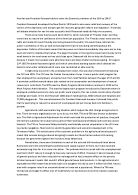Assess the importance of the President in the expansion of the USA from 1815-1917
Assess the importance of the President in the expansion of the USA from 1815-1917
It can be seen that the various Presidents of the United States contributed to expansion between 1815 and 1917, this essay will explore to extent to which they contributed to expansion.
President James Monroe can be seen as a President who didn’t contribute greatly to the expansion of the USA between 1815 and 1917. An example of how Monroe took a more backseat role in expansion is his actions in Florida’s first Seminole War in 1918. Here the USA was trying to unite escaped slaves living in the Seminole bands with their owners and it was at this point Monroe sent in General Andrew Jackson to retrieve them. However Jackson overstepped his mark and ended up pressuring Spain into selling Florida to the USA. The selling of Florida to American meant that the USA now had more land for exploitation and settlements and had reduced Spanish influence on a more global scale. It can be seen that it was the character of Andrew Jackson, not the role of President Monroe that led to the USA gaining more land. The actions of Jackson sparked a bitter debate within the government; during all this Monroe did little if anything to subdue the conflict. Historian Joe Knetsch says that Monroe ‘remained relatively quiet, allowing a long and acrimonious debate to play out before taking a vacation.’This suggests that Monroe didn’t see this as very important. There were other factors that led to the USA gaining Florida such as luck. The USA had been interested in the Seminole bands for some time but never had an opportunity to act on it, the issue of the escaped slaves spurred America into action and helped them gain land they had already wanted. Another factor is the strength of the USA compared to Spain. The USA had a stronger navy and more powerful army than Spain and therefore it was easier to defeat them. However I believe that the key factor in the annexation of Florida to the USA was the character of Andrew Jackson and not President Monroe, this view is supported by historian Milton Meltzer who says ‘without a declaration of war upon Spain, an American General (Jackson) had captured Spanish forts and ousted their commanders’.
President Andrew Jackson was a key figure in Indian Removal. Jackson aggressively pursued plans to move the Indian tribes living in the east of the Mississippi river to the west. Contrary to Jefferson’s idea that the Native American’s could be integrated into American society, Jackson believed that they could not be civilised. During his election, his pro-removal opinions were well known, and so it can be seen that Indian Removal was inevitable, this is supported by Grant Foreman who says ‘Logically one of the first important measures to be urged by Jackson after his election was what became known as the Indian Removal Bill’. This shows that it was Jackson’s opinion that led to Indian Removal. Despite widespread opposition, by 1837 the Jackson administration had removed 46,00 Native Americans from their homes. This opened up 25 million acres of land for white settlement, slavery and access to the gold that lay in the Native’s land. The removal of the Native Americans also led to the expansion of the Transcontinental Railroad making travel and trade much faster. As a whole the Indian Removal Act benefited the USA economically and territorially as white settlers now had more land to develop and prosper from and could begin to mine and sell gold. Therefore, President Jackson was important in the expansion of the USA because his Removal Act led to gains in land and resources. However it can be argued that it wasn’t solely President Jackson’s actions that led to Indian Removal. The discovery of gold in the Cherokee Indian’s land in Georgia led to a dispute between the white settlers and the Native Americans. This saw the State of Georgia fight for









